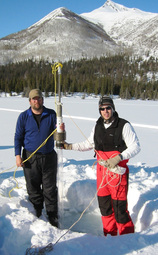Highlight
Assessing Potential Anthropogenic Climate Change in Three Distinct Geographic Regions Along Climatic Zone Margins Using Paleolimnological Proxies
Achievement/Results
Jay Hodgson’s IGERT dissertation research has extended the two-region comparative model developed for our IGERT Freshwater Sciences program to a 3-region study. He is integrating information from lake sediment analysis (paleolimnology) to discern recent climate history and predict future climate trends in each region. The research is designed as a cross-regional comparison of climate change using lakes as high resolution data archives, a novel approach in both lake ecology and climate studies.
Extensive scientific efforts are currently underway globally to explore the magnitude and general effects of post-industrialization climate change. While global temperatures are predicted to rise between 1.5 and 5.5 degrees Celsius over the next 100 years, the magnitude of warming on smaller spatial scales is highly variable and often uncertain. For example, warming in the arctic is forecasted to be much more rapid than warming in the tropics. This range in regional climate change prediction is one of many reasons why global general circulation climate models often provide different warming estimates with large confidence intervals. Therefore, in order to improve global forecasting models, additional research is needed that focuses on mechanisms of climate change at smaller scales. Once more regional data are calibrated into global models, it will be possible to make more accurate warming predictions with smaller confidence intervals.
Our research focuses on understanding climate change in three very different geographical regions: sub-arctic Alaska, sub-tropical Alabama, and semi-arid New Mexico. Each of these three regions represents a very different climate, but within a single continent. Each of these regions is also expected to have a different response to climate warming over the next 100 years. Indeed, Alaska is expected to warm rapidly (above 5.5 degrees C), Alabama is expected to have increased precipitation and slightly lower warming rates (2 to 3 degrees C), and New Mexico is expected to have an intermediate warming (3 to 4 degrees C) accompanied with an increase in severe droughts. Understanding both the driving mechanisms and responses to climate change in each of these three regions will provide valuable information aiding in the improvement of global climate predictions.
Our approach to understanding climate change in these three regions uses historical climate clues stored in lake sediments. Lakes are excellent historical archives of past environmental changes because lakes often change in response to changes in the landscape and climate. Each year, lakes lay sequential sediments on their bottom. These sediments include clues about the changes in landscape and climate. A systematic examination of these sediments can provide great insight into the climate change over many years. Furthermore, it is also possible to use past trends stored in the sediments to project potential future trends. Within our sediment samples, we used both biotic and geochemical proxies that indicate the presence of climate change. Specifically, we are examining diatoms and stable isotopes of Carbon and Nitrogen. Diatoms are microscopic photosynthetic protists that make silica frustules that preserve very well in the sediments. More importantly, diatoms also have a very well-documented ecology as excellent indicators of temperature changes in water. Stable isotopes of Carbon and Nitrogen are also useful indicators of temperature changes because as a lake warms, it often becomes more productive and has more photosynthesis. As a result, the Carbon and Nitrogen ratios will change. The same effect, in the opposite direction, is also present when the lake cools. Collectively, our biotic and geochemical approach yield high resolution data of climate signals.
To date, we have results indicating cyclical climate change in both Alabama and Alaska. Within both regions, we were able to detect global change phenomena, such as the Medieval Climate Optimum (warming) and the Medieval Climate Minimum (cooling, sometimes called “The Little Ice Age”). Additionally, we were also able to detect climate change on smaller scales unique to each region. Within Alabama, we have evidence that warming was associated with an increase in terrestrial water inundation, which may be linked to rising sea levels and increased precipitation. Conversely, in Alaska, our results indicate that cooler temperatures were often associated with increases in precipitation. We are currently in the process of using these historical data to model potential future scenarios in each region. Based on our past evidence of cyclical climate change, we have evidence that there may be an emerging tipping point, originating around the time of industrialization, that indicates a large change in climate is forthcoming.
Address Goals
Our research was made possible through IGERT because we integrated both interdisciplinary science and interregional comparisons. Our approach to assessing climate change comes from the combination of biology, hydrology, paleoecology, geochemistry, and atmospheric science. We were able to further explore these disciplines using our interregional study design.
Alabama, Alaska, and New Mexico all have very distinctly different hydrological cycles and temperature regimes. By examining the differences between hydrology and temperatures, we were also able to identify similarities and contrasts in both climate histories and biotic and geochemical proxies used to make those climate histories.
These similarities and contrasts allow us to find strengths and weaknesses in regional climate change science, which will ultimately lead to a more robust interpretation of past cycles and improved modeling of future scenarios than we currently have. Therefore, the IGERT Freshwater Sciences program allowed us to design a study that incorporated an interdisciplinary approach, which is something single disciplinary grants would not foster. More importantly, however, because our IGERT program is based on interregional differences, we were able to design a multiregional study, which would not be possible with other research grants, to fill in the current gaps in climate change research at smaller, regional scales.






